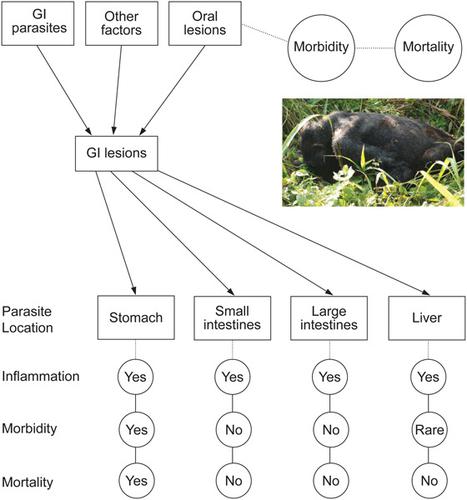当前位置:
X-MOL 学术
›
Am. J. Primatol.
›
论文详情
Our official English website, www.x-mol.net, welcomes your
feedback! (Note: you will need to create a separate account there.)
Pathological lesions of the digestive tract in free-ranging mountain gorillas (Gorilla beringei beringei)
American Journal of Primatology ( IF 2.0 ) Pub Date : 2021-06-07 , DOI: 10.1002/ajp.23290 Denis Muhangi 1 , Chris H Gardiner 2 , Lonzy Ojok 3, 4 , Michael R Cranfield 5 , Kirsten V K Gilardi 5 , Antoine B Mudakikwa 6 , Linda J Lowenstine 7
American Journal of Primatology ( IF 2.0 ) Pub Date : 2021-06-07 , DOI: 10.1002/ajp.23290 Denis Muhangi 1 , Chris H Gardiner 2 , Lonzy Ojok 3, 4 , Michael R Cranfield 5 , Kirsten V K Gilardi 5 , Antoine B Mudakikwa 6 , Linda J Lowenstine 7
Affiliation

|
The finding of parasites and bacterial pathogens in mountain gorilla feces and oral lesions in gorilla skeletal remains has not been linked to pathological evidence of morbidity or mortality. In the current study, we conducted a retrospective study of digestive tracts including oral cavity, salivary glands, esophagus, stomach, intestines (gastrointestinal tract [GI]), liver, and pancreas of 60 free-ranging mountain gorillas from Uganda, Rwanda, and the Democratic Republic of Congo that died between 1985 and 2007. We reviewed clinical histories and gross pathology reports and examined histological sections. On histology, enteritis (58.6%), gastritis (37.3%), and colitis (29.3%) were the commonest lesions in the tracts. Enteritis and colitis were generally mild, and judged likely to have been subclinical. Gastritis was often chronic and proliferative or ulcerative, and associated with nematodiasis. A gastro-duodenal malignancy (carcinoid) was present in one animal. A number of incidental lesions were identified throughout the tract and cestodes and nematodes were frequently observed grossly and/or histologically. Pigmentation of teeth and tongue were a common finding, but periodontitis and dental attrition were less common than reported from past studies of skeletal remains. Despite observing numerous GI lesions and parasites in this study of deceased free-living mountain gorillas, we confirmed mortality attributable to gastroenteritis in just 8% (5/60) cases, which is less than that described in captive gorillas. Other deaths attributed to digestive tract lesions included cleft palate in an infant, periodontal disease causing systemic infection in an older adult and gastric cancer. Of all the parasitic infections observed, only hepatic capillariasis and gastric nematodiasis were significantly associated with lesions (hepatitis and gastritis, respectively). Understanding GI lesions in this endangered species is key in the management of morbidity associated with GI ailments.
中文翻译:

散养山地大猩猩 (Gorilla beringei beringei) 消化道的病理病变
在山地大猩猩粪便和大猩猩骨骼遗骸口腔病变中发现的寄生虫和细菌病原体与发病率或死亡率的病理学证据无关。在目前的研究中,我们对来自乌干达、卢旺达和卢旺达的 60 只自由放养的山地大猩猩的消化道进行了回顾性研究,包括口腔、唾液腺、食道、胃、肠(胃肠道 [GI])、肝脏和胰腺。 1985 年至 2007 年间死亡的刚果民主共和国。我们回顾了临床病史和大体病理报告,并检查了组织切片。在组织学上,肠炎 (58.6%)、胃炎 (37.3%) 和结肠炎 (29.3%) 是肠道中最常见的病变。肠炎和结肠炎通常是轻微的,并且被判断可能是亚临床的。胃炎通常是慢性的、增殖性或溃疡性的,并与线虫病有关。一只动物存在胃十二指肠恶性肿瘤(类癌)。在整个管道中发现了许多偶然的病变,并且经常在肉眼和/或组织学上观察到绦虫和线虫。牙齿和舌头的色素沉着是一个常见的发现,但牙周炎和牙齿磨损不像过去骨骼遗骸研究报告的那样常见。尽管在对已故的自由生活山地大猩猩的这项研究中观察到了许多胃肠道病变和寄生虫,但我们证实胃肠炎导致的死亡率仅为 8% (5/60),低于圈养大猩猩中描述的死亡率。其他归因于消化道病变的死亡包括婴儿腭裂、导致老年人全身感染的牙周病和胃癌。在观察到的所有寄生虫感染中,只有肝毛细血管病和胃线虫病与病变(分别为肝炎和胃炎)显着相关。了解这种濒危物种的胃肠道病变是管理与胃肠道疾病相关的发病率的关键。
更新日期:2021-07-22
中文翻译:

散养山地大猩猩 (Gorilla beringei beringei) 消化道的病理病变
在山地大猩猩粪便和大猩猩骨骼遗骸口腔病变中发现的寄生虫和细菌病原体与发病率或死亡率的病理学证据无关。在目前的研究中,我们对来自乌干达、卢旺达和卢旺达的 60 只自由放养的山地大猩猩的消化道进行了回顾性研究,包括口腔、唾液腺、食道、胃、肠(胃肠道 [GI])、肝脏和胰腺。 1985 年至 2007 年间死亡的刚果民主共和国。我们回顾了临床病史和大体病理报告,并检查了组织切片。在组织学上,肠炎 (58.6%)、胃炎 (37.3%) 和结肠炎 (29.3%) 是肠道中最常见的病变。肠炎和结肠炎通常是轻微的,并且被判断可能是亚临床的。胃炎通常是慢性的、增殖性或溃疡性的,并与线虫病有关。一只动物存在胃十二指肠恶性肿瘤(类癌)。在整个管道中发现了许多偶然的病变,并且经常在肉眼和/或组织学上观察到绦虫和线虫。牙齿和舌头的色素沉着是一个常见的发现,但牙周炎和牙齿磨损不像过去骨骼遗骸研究报告的那样常见。尽管在对已故的自由生活山地大猩猩的这项研究中观察到了许多胃肠道病变和寄生虫,但我们证实胃肠炎导致的死亡率仅为 8% (5/60),低于圈养大猩猩中描述的死亡率。其他归因于消化道病变的死亡包括婴儿腭裂、导致老年人全身感染的牙周病和胃癌。在观察到的所有寄生虫感染中,只有肝毛细血管病和胃线虫病与病变(分别为肝炎和胃炎)显着相关。了解这种濒危物种的胃肠道病变是管理与胃肠道疾病相关的发病率的关键。











































 京公网安备 11010802027423号
京公网安备 11010802027423号